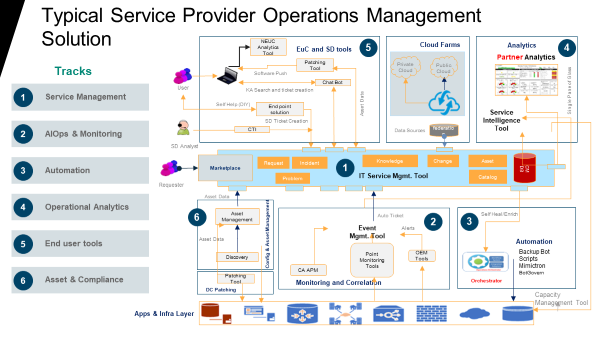How to Improve Your Operating Margin with a Modern ITOM Solution
Use SaaS-based tools to improve margins, get a "single pane of glass" view for more accurate IT management data.
August 4, 2023


Sreenivasan Subramanian
A couple of decades ago I sat down with my manager to consider how to improve the project’s operating margins. The conversation went something like this:
“Let’s replace some high-cost resources with cheaper ones.”
“Can we reduce the bandwidth of the internet links?”
“Should we move from AT&T to Singtel?”
“Could we move to a smaller offsite delivery center? ”
These were the typical avenues that we considered. I’m quite sure this resonates with a lot of the readers who worked in IT services leadership positions with P&L responsibilities in those days.
Twenty years later, I would say that this kind of cost-cutting pressure happens on a much larger scale today for delivery teams. With the evolving macroeconomic conditions and their impact across industries, service providers and enterprise IT teams are increasingly challenged with delivering differentiated and cost-effective services while striving to maintain and/or improve their operating margins. This has pushed organizations to increasingly look at modern IT management tools to enable them to drive profitable margins, while not compromising on the quality of service to their customers.
Enter IT Management Tools
For decades, service provider organizations have tried using different tools to enable their operations. Until about a decade ago, positioning multiple tools as part of the solution was a norm. These were either siloed tools or different tools from the same vendor. Multiple resources were put in place to manage these tools. The picture below is a typical representation of how many tools were used.

Source: OpsRamp
The challenges with this approach were that the total cost of the solution was high and interoperability of the tools was a challenge. As the service providers tried to drive more value, re-engineering the solution was a nightmare that led to them introducing more tools into the ecosystem, further compounding the problem. Another challenge was the number of agents loaded onto servers or end-user devices, as every tool brings their own agents to collect information.
This brought a new problem from a security perspective — the enterprise IT security teams didn’t want so many agents loaded on hardware environments as it increased the number of entry points for security breaches. This led to certain critical environments being omitted from management and monitoring, which created more manual, error-prone work for the service provider teams.
Data consolidation and sharing across multiple teams and for different purposes was also a challenge as there were too many data collection entities to manage and consolidate. Service providers found it extremely difficult to run any automation strategies for their customers due to this tool sprawl. The result was the increasing cost of the tools solution, a lack of scalability to improve service quality, and difficulty creating value for customers. This scenario is still all too common today.
3 Ways Service Providers Can Overcome Challenges
How can service providers overcome these challenges? Let’s look at the top three themes that will help service providers modernize their solutions and enable them to improve operating margins while delivering …
… a value-driven experience to their customers.
Reducing the total cost of ownership: Consolidating the existing, siloed tools can help service providers reduce license costs and management overhead. Since in most cases the license costs are embedded into the unit price of the service, the savings will improve the service provider’s margins. Service providers should look for single tools that can replace most of the functions of the multiple tools they have in place. They can then have specific tools catering to key IT operations functions, such as having one tool that does monitoring, event management, and auto-ticketing for the internal infrastructure and multicloud environments. They can have one tool that specializes in application monitoring, one tool that specializes in multiple end-user device management, and so on.
While selecting such tools, service providers should ensure the tools can scale to drive new use cases, to avoid re-engineering work as tool use expands. This approach not only reduces the amount of money spent on tools, but also the number of resources needed to support the tools. Service providers should also look at converging skills, so that one technician can manage multiple tools. For this the tools should also have minimal dependencies for management. SaaS-based tools can help as the core platform is always managed by the software-as-a-service tool provider.
Creating a single source of truth: Often in service provider solutions the front line teams, which are of L1/L1.5 skill set, like a network command center or a service desk that handles monitoring and incident management, form a critical aspect of their operations. These teams, in most cases, struggle with having to deal with multiple screens for monitoring the customer environment and for triaging incidents. These teams are also challenged with having to manually create incident tickets from monitoring systems. This often leads to service providers struggling to optimize these teams or enabling these teams to manage L2 level tickets, which could have allowed them to optimize the L1:L2:L3 pyramid structure many service providers use.
Having tools that can consolidate the monitoring view into a “single pane of glass” will help bring about these optimizations. While looking to do this, service providers should look at capabilities that allow them to gain a sole source of truth by combining metrics, events, topology, analytics, logs and traces across the customer’s diverse IT environment. Modern ITOM tools make it easier to consolidate data and simplify data management. This will allow the service providers to extend and share the data collected for other analytics purposes. Some tools come with the capability to apply artificial intelligence and machine learning to this data for predictions, forecasting and real-time intelligence on service impacts, a step that significantly reduces business outages and improves the overall IT operation’s efficiency.
Automation: This is a very tried and tested area, but many service providers have faced challenges to successfully automating IT operations. The primary reason is the lack of interoperability of the tools being used. Service providers need a tool that simplifies this automation. Many service providers based their automation strategies on incident tickets that were created in the IT service management tools. But incident management is, by definition, a very reactive process; it’s about responding to incidents as they occur.
Modern IT operations management (ITOM) tools enable automation to run based on alerts and at the event-management layer. This means that pre-emptive, proactive actions can be taken. This can benefit the operations teams by enabling them to resolve many of the issues via automation before they impact customer experience. Service providers can now optimize the L1 and L2 service teams by looking at opportunities where issues can be auto-resolved by the tool. This approach enables them to optimize and/or even converge teams. So, there would be no L1 team, but instead there would be an L1.5 team that does L1 and L2 level work, thereby greatly reducing the cost of operations, and improving the end-customer experience.
ITOM Tool Benefits
Service providers today are increasingly looking at SaaS-based tool solutions to drive optimization, improve operating margins and customer outcomes and grow their business with a modern approach to IT operations management.
Adopting new ITOM tools as a part of this modernization effort can yield several benefits, including:
Reduction in the number of IT management tools and the costs and resources needed to support those tools.
A “single pane of glass” view that yields more accurate IT management data and prepares service providers for effective AIOps initiatives.
The ability to automate IT operations at the event-management level and support taking pre-emptive actions to prevent IT incidents from occurring in the first place.
Sreenivasan Subramanian is director of partner solutions at OpsRamp, now part of Hewlett Packard Enterprise. He previously worked at Wipro Limited and HCL Technologies infrastructure services division. You may follow him on LinkedIn or @OpsRamp on X.
Read more about:
MSPsAbout the Author(s)
You May Also Like


